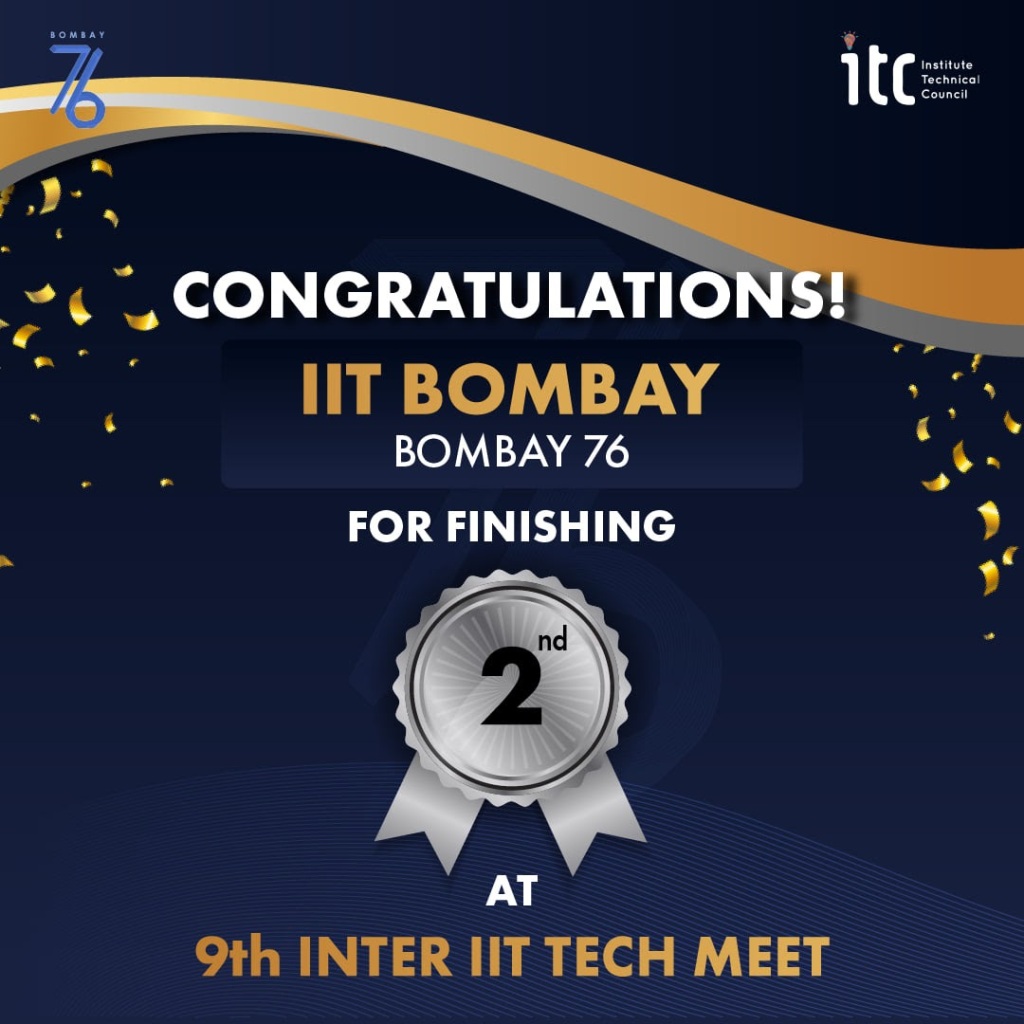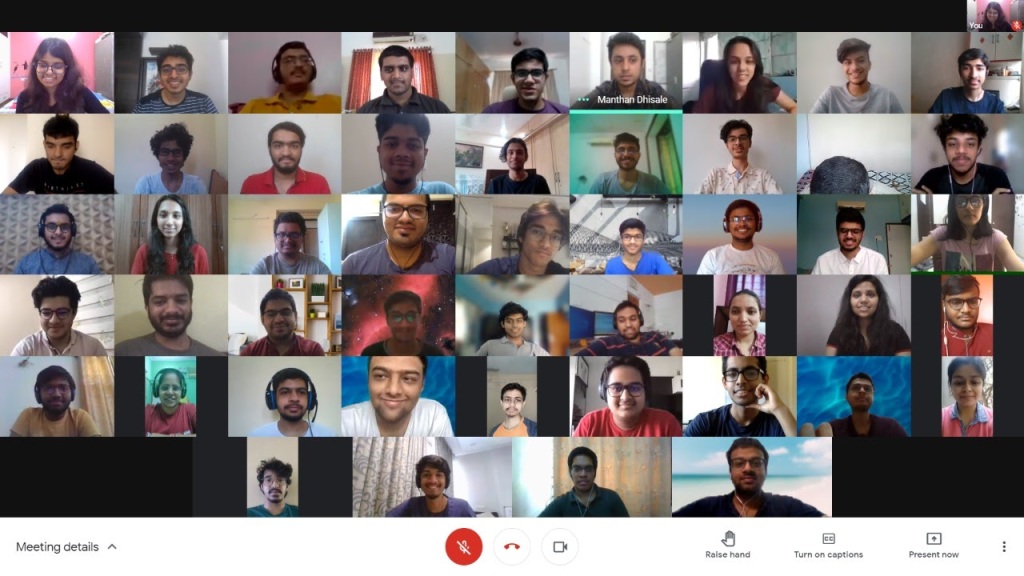Disclaimer: The content on this website is strictly the property of Insight, IIT Bombay. Content here cannot be reproduced, quoted or taken out of context without written permission from Insight. If you wish to reproduce any content herein, please contact us:
Chief Editors: Adarsh Prajapati (adarsh.p@iitb.ac.in), Shivam Agarwal (22b2720@iitb.ac.in)
Mail to: insight@iitb.ac.in
Recently, another accolade was added to our institute’s long list of achievements in the tech sphere. The IIT Bombay contingent, branded “Bombay76” at this year’s Inter IIT Tech Meet, achieved the first runner’s-up, grabbing 3 Gold, 2 Silver, and 4 Bronze Medals. Hosted by IIT Guwahati on 27th-28th March, the event took place in online mode, which presented the contingent with some unprecedented challenges. Still, by virtue of the efforts put in by the contingent leaders, backed up by an enthusiastic Institute Technical Council, and the hard work of each contingent member involved, our college was able to perform spectacularly well, bagging the second position in the overall championship.

The Inter IIT Tech meet is an annual event in which the 23 IITs from all across the country compete with each other. IITs send the best of their lot to try their hands on the practical, real-world problems put forward by leading organizations of various technical fields. The tech Meet also involves showcases, like engineer’s conclave (EC) and Student’s Academic conclave, where students get a chance to present technical activities inside their institutes like significant projects running in the institute and relevant research papers published in the specified fields. This year, a substantial chunk of problem statements were proposed by organizations like Bosch, Jaguar, ISRO, etc. The problem statements begin to be released almost one month before the two main event days that mark the tech meet’s end (27th and 28th March this year). The teams had to present and elaborate their submissions for each problem statement on the final days where industry experts and professors judged them.
There are broadly three kinds of problem statements:
- High prep Problem statements: Month-long events worth 400 points each.
- Medium prep Problem statements: Couple weeks long, worth 250 points each.
- Low prep Problem Statements: A week-long at most, 150 points each.
The showcases were both worth 150 points each.
This year saw some new and interesting problem statements. Here are some experiences from the team leaders involved in these problem statements:
Siddharth Maniar (Team leader: Product Management P.S.):
“Our team was a highly balanced one with every person having their expertise, ranging from design, technology and strategy-making. The problem which was based on a startup was quite open-ended and it tested our skills to prioritise and find the best fit using the first principles. The competition taught us to work coherently among varied timelines, acted as a forum for us to connect with like-minded people across other IITs and brought out the best in us to fight for the glory of our beloved insti.”
Tushar Dhawal (Team leader: Algorithmic Trading P.S.):
“Our team had a good mix of experience and enthusiasm which showed in the type of decisions we took in the face of massive uncertainty and ambiguity. We gained a lot of practical knowledge about the financial markets and were proved wrong on numerous occasions only to bounce back with better trades and algorithms. All of us in the team learnt the importance of thinking calmly and quantitatively under pressure, without giving in to whatever was happening in the markets or getting bogged down by wrong decisions made by us in the past.”
Even the traditional categories like cybersecurity didn’t follow the historical trend and were reframed to be more practical. Here is what Himanshu Sheoran, team lead in the category, has to say about his experience this year:
“This year the PS was a departure from the usual CTF styled cybersecurity competitions which we excel on, but was rather more realistic in nature. We were posed with a set of 5 CVEs (Common Vulnerabilities and Exposures) on web servers, which required the environmental setup for triggering the vulnerability and developing a proof of concept exploit for the vulnerability. Working in a team with quite experienced people, we managed to exploit and demonstrate all 5 vulnerabilities which eventually landed us with a gold! It was a thrilling experience to lead such an awesome team, all of us gained crucial presentation skills which otherwise are not so prominent in winning a CTF.”
Once the problem statements were released, the first and foremost task was team selection.
The contingent had major challenges in this task. Firstly, teams had to be selected in a very short period of time. Here’s what Contingent Leader Aryan Agal has to say about this database.
“The database worked on an invite based system. It served as a quick reference for us, for when the problem statements would be released. However, the goal of the database was broader than just Inter IIT [Tech Meet]. We hoped that the database would serve as a handy resource for the Institute’s technical competitions and events.”
Selected candidates from this database were interviewed and appointed as team leads. Further, forms were sent out on the common students’ forum to select the rest of the team. While the selection process for the high prep and the mid prep problem statements took 2 to 3 days with minimum filtering, the low prep selection had to be done quicker with high filtering.
Some of the students with expertise and interest in tech were mostly involved with various tech teams. These students were unable to participate or provide any help since they had their own competitions clashing with the schedule of Inter IIT. This was another hurdle that they had to overcome.
Further, they had to also look for mentors for the teams along with the selection process. Professors, alumni and seniors were contacted for this purpose. PG students working on their theses, along the lines of the competition, provided a great deal of mentorship to the teams. The teams had also contacted various labs to gain more insight on the high prep and the mid prep problems.
One disadvantage that our contingent faced was that the high prep problem statements were released during our mid-semester examinations. Due to the institute’s blackout policy during this period, we started some 4-5 days late. Still, our team gave in a lot of efforts, managed to bag medals in all of the high prep statements and had learnt a lot of things in the process.
Shaurya Sindhu, who led the team for a high prep entrepreneurship problem statement says that, “The PS demanded us to deliver tech-led solutions for rural entrepreneurs that could help elevate the rural youth and strengthen the market linkages. It was interesting to solve problems for a sector that still employs hundreds of year-old practices while contributing 20% to the GDP. The team brought various perspectives with business expertise, strategy building, entrepreneurship & a deep-seated understanding of rural ailments. It was a very steep learning curve for all of us, going from a bucket of ideas and no market expertise to developing an end-to-end robust supply chain by understanding pain points for all the stakeholders involved. Lastly, the competition taught us to admire our farmers even more for the challenges they face while still feeding the nation.”
Also, there were some problem statements like ISRO’s and Jaguar Land Rover’s where our team outperformed the opponents by a huge margin.
Kunal Deshmukh, co-leading ISRO’s PS, describes his experience of leading the team to gold.
“The Astro PS this time around was a mix of web development/visualisation and astronomical data analysis. In our well-balanced team of 8, we had multiple people with experience in both aspects of the PS. We also had people from the IITB astrophysics group to consult with and get additional perspectives. We had to push ourselves right up to the eleventh hour, but in the end, all the hard work of our team paid off well and we topped with quite a margin. That being said, winning the gold was extremely satisfying, and the best part is yet to come – we will be working with ISRO to make this tool even better, ultimately for them to implement it publicly.”
Contingent Leader Manthan Dhisale, who was also the lead of Jaguar Land Rover’s competition shares his experience on tackling the problem statement.
“This year the PS from Jaguar Land Rover was in the electromechanical domain. We needed to design a Damper energy harvesting system for a quarter car model which demanded mixed expertise from Mechanical, Electrical and Electronic disciplines. The team that we assembled not only brought in their respective expertise but also were really keen on learning the work happening in other disciplines. Overall we would summarize our journey as a perfect knowledge transfer and a memorable yet adventurous tech-ride package for a 5-day trip!”
On asking about the comeback from last year’s performance, the Contingent Leaders quoted that “Failures are stepping stones to success.”
They said that the current team learnt lessons from the experiences of the last meet and improved upon them to come back strong and bag runners up prize this year. They managed to get a good database of the people, which helped a lot in the selection process. A good mentorship network was established for guiding the team members to tackle the issues faced by them. The inputs from tech teams and the tech council proved to be quite helpful. Extensive mock presentations and reviews were conducted to prepare our team for the final event. These things contributed to our team’s success at the event.
Concluding Remarks from the Contingent Leaders
“The problems statements in the tech meet are floated by the industry experts and these [problems] do matter to them. The industries might also implement the solutions which you offer to them. It is an opportunity to show your skills, improve them and also to a certain extent network with people from other IITs and the industry. Such opportunities don’t knock on your very door often.”

Here are some important links:
The overall scores and standing in each event
The official solutions of the IITB contingent (includes reports, presentations and the problem statement PDFs)
The team presentations (recorded live on competition day)
0